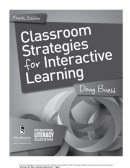
Classroom Strategies for Interactive Learning
Interactive learning is a powerful approach that engages students and enhances their understanding of the material. By incorporating interactive strategies into the classroom, educators can create a dynamic learning environment that promotes active participation and critical thinking.
Group Discussions
Encourage students to participate in group discussions where they can share their ideas, ask questions, and engage in collaborative problem-solving. Group discussions promote communication skills, teamwork, and a deeper understanding of the subject matter.
Hands-On Activities
Hands-on activities such as experiments, simulations, and projects provide students with practical experience and reinforce theoretical concepts. These activities cater to different learning styles and help students apply their knowledge in real-world scenarios.
Technology Integration
Integrate technology tools such as interactive whiteboards, educational apps, and online resources to enhance the learning experience. Technology can facilitate interactive lessons, personalized instruction, and instant feedback for students.
Gamification
Incorporate elements of gamification into the classroom to make learning fun and engaging. Use game-based activities, quizzes, competitions, and rewards to motivate students and stimulate their interest in the subject matter.
Peer Teaching
Encourage peer teaching where students take turns explaining concepts to their classmates. Peer teaching not only reinforces the material for the student teaching but also helps other students learn from their peers in a collaborative setting.
In conclusion, interactive learning strategies empower students to take an active role in their education and foster a deeper understanding of the material. By implementing these strategies in the classroom, educators can create a dynamic learning environment that promotes engagement, critical thinking, and academic success.
6 Effective Classroom Strategies for Promoting Interactive Learning
- Encourage group discussions and collaboration among students.
- Incorporate hands-on activities and experiments to enhance learning.
- Use technology such as educational apps or interactive whiteboards for engagement.
- Provide opportunities for students to present their ideas and projects to the class.
- Implement peer teaching where students can learn from each other.
- Offer constructive feedback and praise to motivate students.
Encourage group discussions and collaboration among students.
Encouraging group discussions and collaboration among students is a highly effective classroom strategy for promoting interactive learning. By engaging in group discussions, students have the opportunity to share their perspectives, ask questions, and work together to solve problems. Collaboration fosters communication skills, critical thinking, and teamwork, creating a dynamic learning environment where students can learn from each other’s ideas and experiences. This interactive approach not only enhances understanding of the material but also cultivates a sense of community and mutual support among classmates.
Incorporate hands-on activities and experiments to enhance learning.
Incorporating hands-on activities and experiments is a highly effective classroom strategy for promoting interactive learning. By engaging students in practical experiences, educators can deepen their understanding of complex concepts and foster a sense of curiosity and exploration. Hands-on activities not only make learning more enjoyable but also provide students with valuable real-world skills that they can apply beyond the classroom. Through experimentation, observation, and analysis, students develop critical thinking skills and problem-solving abilities that are essential for academic success and lifelong learning.
Use technology such as educational apps or interactive whiteboards for engagement.
Utilizing technology, such as educational apps and interactive whiteboards, is a valuable tip for enhancing engagement in interactive learning within the classroom. These tools offer dynamic ways to present information, encourage active participation, and provide immediate feedback to students. By incorporating technology into lessons, educators can create a more interactive and stimulating learning environment that caters to diverse learning styles and fosters deeper understanding of the subject matter.
Provide opportunities for students to present their ideas and projects to the class.
One effective tip for promoting interactive learning in the classroom is to provide opportunities for students to present their ideas and projects to the class. By allowing students to showcase their work in front of their peers, educators not only encourage public speaking skills but also foster a sense of confidence and ownership over their learning. Presentations promote active engagement, critical thinking, and peer-to-peer learning as students share their perspectives and insights with the class. This strategy creates a collaborative environment where students can learn from each other’s experiences and develop a deeper understanding of the subject matter through interactive discussions and feedback sessions.
Implement peer teaching where students can learn from each other.
Implementing peer teaching in the classroom is a valuable strategy that allows students to learn from each other. By encouraging students to take on the role of teacher and explain concepts to their peers, this approach not only reinforces their own understanding of the material but also creates a collaborative learning environment where knowledge is shared and exchanged. Peer teaching promotes active engagement, critical thinking, and communication skills, ultimately enhancing the overall learning experience for all students involved.
Offer constructive feedback and praise to motivate students.
Offering constructive feedback and praise to students is a crucial aspect of interactive learning strategies. By providing specific feedback on their performance, educators can guide students towards improvement and reinforce positive behaviors. Constructive criticism helps students identify areas for growth and encourages them to strive for excellence. Additionally, praising students for their efforts and achievements boosts their confidence and motivation to continue learning. This combination of feedback and praise creates a supportive learning environment where students feel valued, empowered, and motivated to actively engage in the learning process.
